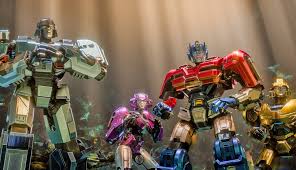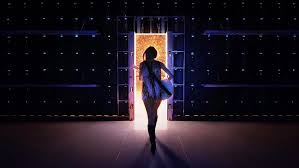Transformers One 2024 Movie Review
Upon its release in 1986, Nelson Shin’s “The Transformers: The Movie” was massively influential — less as entertainment inspired by a popular line of children’s toys than one that was willing to kill off a major character in order to make room for new ones. The death of heroic Autobot leader Optimus Prime proved so traumatic to a generation of young viewers that toy company Hasbro scrambled to rescue Duke from a similar fate in “G.I. Joe: The Movie,” released a year later. For almost four decades, it prevented many family-friendly toons from raising the stakes too high. Thankfully, “Transformers One” mostly ignores its predecessor’s downstream legacy.
Now, in the first animated film in the franchise to play theatrically since that one, director Josh Cooley doesn’t commit widespread Cybertronian genocide. That wouldn’t do, since “Transformers One” serves as an origin story for the central conflict between Autobots and Decepticons that the various animated series, live-action films and various media spinoffs have explored since the toy line debuted. And yet, while still delivering the fun and excitement expected of Hasbro’s metamorphosizing robots, “Transformers One” approaches the well-known characters with a degree of nuance and complexity (as well as violent finality, in a few cases) that marks the most sophisticated onscreen portrait of them to date.
Lending their voices as Orion Pax and D-16, Chris Hemsworth and Brian Tyree Henry play the two droids who will one day become Optimus Prime and Megatron. Eager to make his mark on Cybertronian society, Orion dreams of the two of them rising above their current station as miners of Energon, the energy source for the planet that has all but evaporated. Meanwhile, D-16 is more cautious and fearful of upsetting the status quo, even if it means a life of glamorless servitude.
Though neither possesses a cog — the part that allows these robots to transform — Orion enters them in a celebratory race in hopes of getting seen by Sentinel Prime (Jon Hamm), the last remaining Prime after his brethren were killed by the ruthless extraterrestrial species, the Quintessons. His plan works, but Prime’s attention proves short-lived and they end up on a lower rung of society than before, this time with fellow social reject B-127 (Keegan-Michael Key) and their disgraced former supervisor, Elita-1 (Scarlett Johansson), along for the ride.
In order to redeem themselves, Orion, D-16 and their counterparts travel from their home in Iacon City to the surface to try and locate the Matrix of Leadership, a mythical object with the power to restore the flow of Energon on the planet. Instead they discover an elaborate conspiracy that reaches back to the era of the Primes, with repercussions that affect the identities of nearly all Cybertronians. Armed with this knowledge, they make the dangerous trek back to Iacon City to expose their fellow citizens to the truth, even as they each contemplate how best to move forward once its secrets have been fully revealed.
Despite the expert visual effects work done by Industrial Light & Magic, Digital Domain and others on the first five live-action “Transformers” films, ILM not only exceeds itself here in creating believable animated characters but makes a convincing case that photorealism is not the best aesthetic for bringing them to life on screen. (It’s an argument that was already advanced by Travis Knight on the 2018 installment “Bumblebee,” while Steven Caple Jr.’s “Rise of the Beasts” minimized or eschewed the noisy, overcomplicated machinery of Bay’s movies for something that more closely resembled the characters of the original cartoons.) These are androids that turn into vehicles, after all — and signing up to watch a film about them suggests as a viewer you’ve already accepted the premise. The fact that these characters now have identifiable faces, rather than a swirling mass of pixelated metal, is a big step in itself.
But Cooley, who won an Oscar for directing “Toy Story 4,” does more than simplify these heroes and villains’ familiar silhouettes. He creates a stylized and cohesive reality where these characters are both physically and metaphorically finding their place in the world. The screenplay by Eric Pearson, Andrew Barrer and Gabriel Ferrari not only creates a younger Cybertron than audiences have ever seen, but characters who are less fully formed. As a consequence there’s a mutual transformation that occurs. Orion lacks the resolute authority of Optimus Prime, and D-16 the calculating vindictiveness of Megatron, but as they discover where they’ve come from, each reacts in ways that are simultaneously canonically authentic and deeply relatable.
The dynamic is reminiscent of Caesar and Koba in “Dawn of the Planet of the Apes” — one aspires to champion and embody the best in the world around them, while the other has experienced pain that’s too deep to forget, or forgive. The force that brings those perspectives into conflict proves massive enough to form the central dynamic around which virtually all “Transformers” lore has revolved.
In the midst of all of that philosophical complexity are some absolutely dynamite visuals, including a snakelike track that materializes in a fiendish loop-de-loop in front of the racers as they compete for first place, or the buttes and mountain ranges that spring up like geometric screensavers as Orion, D-16 and their fellow fugitives survey the surface of Cybertron. While building his ‘bot dystopia full of hero moments and brisk action sequences, Cooley manages to inject the film with impressionistic moments that will mesmerize the longtime fans (likely parents) sitting alongside its intended audience — namely, kids in already love with Optimus and Megatron.
By enlisting Steve Buscemi as permanently-sniveling Decepticon Starscream, he also makes one of the single best voice casting choices since Orson Welles as Unicron in “The Transformers: The Movie,” though the remainder of the performers, from Hemsworth and Henry on down to Hamm as glad-handing Sentinel Prime, are all perfectly curated for their roles. Mileage may vary on Key’s motormouthed performance as future Autobot sidekick Bumblebee, but if his humor (and the rest in the film as a whole) is frequently silly, I’d argue that’s preferable to the sophomoric, raunchy, occasionally racist humor of Bay’s live-action films.
At any age, expectations won’t be subverted, but the film offers a more nuanced portrayals of Cybertron’s heroes and villains than ever before, and it furthermore does not pull punches when it comes to the, let’s say, conclusive fates of certain characters. Even so, in an era of more sophisticated animated offerings and the collective seasoning of audiences since 1986, Cooley’s film seems unlikely to prompt the kind of backlash that its predecessor faced. In fact, “Transformers One” holds up well in a particularly robust year for high-quality animated fare: released in close proximity with “The Wild Robot,” another story of machines run amuck, its material may not seem as obviously emotional, but for a viewer who was first traumatized by “The Transformers” 38 years ago, it’s exciting to watch a new installment in this franchise and actually feel something again.




